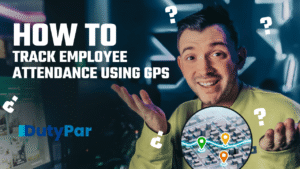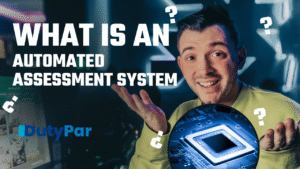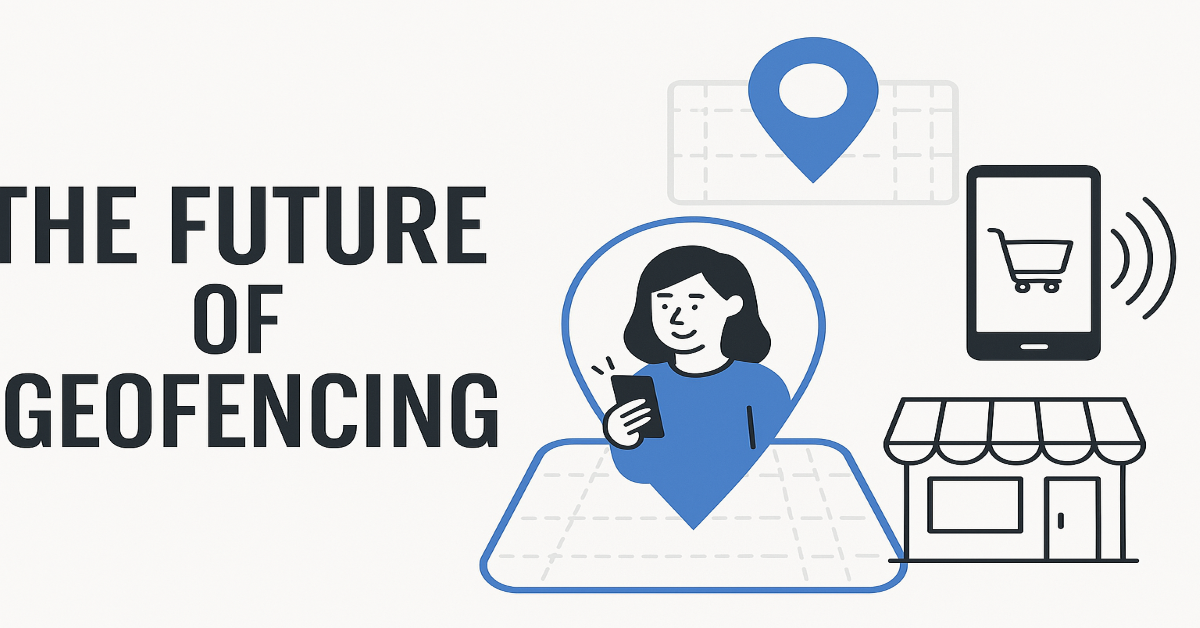
Table of contents
In a fast-paced world, businesses require intelligent tools to lead the way. One tool that is changing things in a hurry is geofencing. This article defines the future of geofencing and why it’s important. We will address what geofencing is, what benefits it has today, and what the future holds. We will also reveal how companies can leverage this technology to enhance their business. The future of geofencing is promising, and its influence on business is evident.
What Is Geofencing?
Geofencing is a place-based technology. It establishes virtual boundaries on the ground. Companies can utilize these virtual borders to promote custom messages or offers to customers who cross a boundary into a certain area. For example, a department store might use geofencing to trigger a special discount for shoppers when they pass its location.
- Setting Boundaries: A digital perimeter is defined using GPS, RFID, Wi-Fi, or Bluetooth.
- Monitoring Movement: When a person crosses this virtual line, the system detects their location.
- Triggering Actions: The system sends notifications or tracks behavior in real time.
The Current Advantages of Geofencing
Today, the benefits of geofencing are well-developing. Many companies are already using this tool to improve customer engagement and boost sales. Some key benefits include:
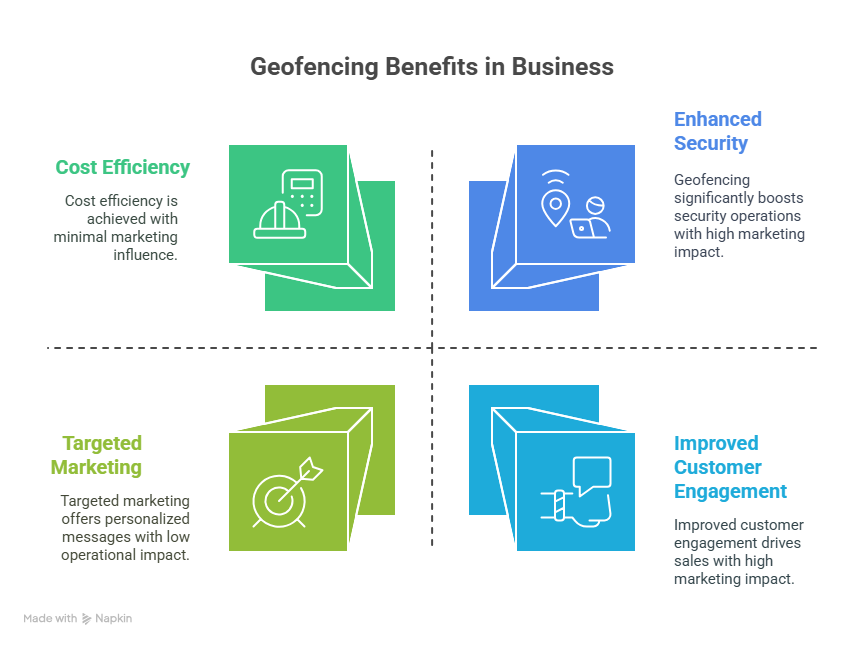
- Targeted Marketing: Businesses can reach customers with personalized offers. The messages are sent only to those in the desired area. This leads to better conversion rates.
- Improved Customer Engagement: Real-time alerts capture customer interest immediately. When shoppers receive relevant offers at the right moment, they are more likely to act.
- Cost Efficiency: Geofencing reduces wasted advertising costs. Instead of mass advertising, businesses spend money on highly focused campaigns.
- Actionable Insights: Marketers track customer behavior and adjust strategies based on data. They learn which areas bring the most traffic and engagement.
- Enhanced Security: Geofencing is not just for marketing. It also helps in security and operations. For instance, companies can use it to track assets and monitor employee movements.
The Future of Geofencing
As we look ahead, the future of geofencing promises exciting changes. This technology is expected to grow in accuracy, speed, and functionality. Here are some trends that will shape the future of geofencing:
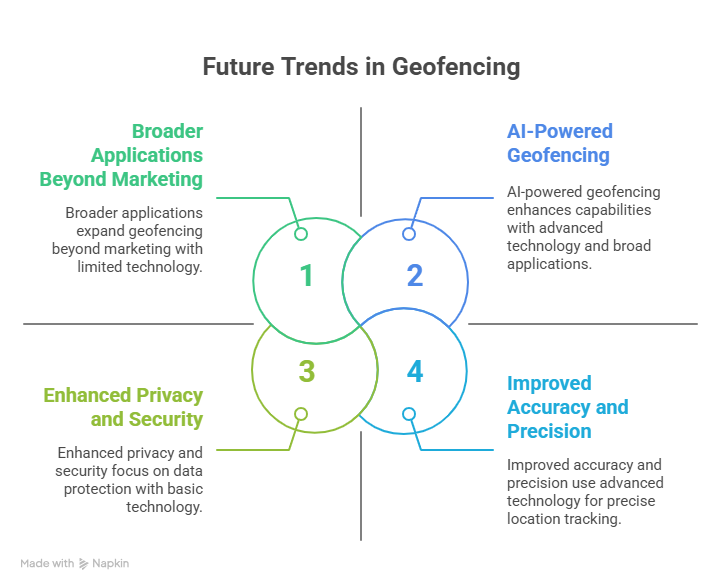
1. Improved Accuracy and Precision
Future geofencing systems will be more precise. The boundaries will be drawn with more precision. That is, a customer’s location can be pinpointed to very small spaces. The enhancement results from technological advancements in GPS and IoT (Internet of Things) sensors. Future geofencing will allow highly specific and localized interactions.
2. Real-Time Data and Instant Feedback
The future of geofencing will be about real-time analytics. Companies will have live updates of customer movements and interactions. This allows for instant tweaking of advertising and promotions. Quicker response times result in increased customer engagement and operational effectiveness.
3. Integration with Mobile Apps and Wearable Devices
When wearable technology is ubiquitous, geofencing will reach even further. Geofencing in the future will seamlessly integrate with smartphones, smartwatches, and other Internet-connected devices. This will enable more extensive tracking and targeted marketing. Businesses can make the customer experience more interactive and immersive.
4. Enhanced Privacy and Security
With greater accuracy comes more demand for privacy. The future of geofencing holds stronger security standards. Enterprises will utilize more sophisticated encryption and data handling protocols. It keeps customer information secure and respects privacy legislation. Consumers will have faith that their location information is secure.
5. Broader Applications Beyond Marketing
Geofencing will not only drive marketing campaigns. Its use will expand to areas such as:
- Logistics and Asset Tracking: Companies will track shipments and manage inventory in real time.
- Public Safety: Authorities can use geofencing for crowd control and emergency alerts.
- Smart Cities: Urban planners will build systems that integrate geofencing to improve public transport and energy management.
6. AI-Powered Geofencing
Artificial intelligence and machine learning will enhance geofencing capabilities. AI will process more data at faster speeds. This will allow for smarter predictions, such as forecasting customer behaviour. The future of geofencing will see AI-driven insights that help businesses optimize operations.
Contrast between Traditional Marketing vs. Future of Geofencing
To see how geofencing stands apart from traditional methods, check out the comparison table below:
| Feature | Traditional Marketing | Future of Geofencing |
|---|---|---|
| Targeting | Broad, mass marketing | Highly targeted, location-specific messaging |
| Accuracy | General area approaches | Precise, real-time location tracking |
| Response Time | Delayed, based on historical data | Immediate, with live data and instant actions |
| Data Insights | Limited customer behavior insights | Real-time insights and AI-driven analytics |
| Cost Efficiency | High cost due to wide outreach | Low cost with focused, optimized campaigns |
| Privacy Security | Varies, potential data risks | Advanced security measures and enhanced user privacy |
Real-World Applications of Geofencing
The future of geofencing is not only about improved technology. It means better practical applications too. Here are some use cases where geofencing makes a difference:
Retail and Customer Engagement
Geofencing will be employed by retailers to send deals and notices. When a shopper enters a store, they can be given targeted offers on their mobile application. This encourages interaction and increases sales. The future of geofencing assists in creating an engaging shopping experience.
Logistics and Supply Chain Management
Businesses may employ geofencing to track deliveries and monitor assets. The real-time location info reduces delays and makes routes more efficient. This results in quicker delivery and enhanced customer satisfaction.
Public Safety and Urban Planning
Municipal governments can utilize geofencing to manage crowds at events. Geofencing is also applicable for emergency alerts. Geofencing will be used in smart cities in the future to optimize citywide public services including traffic management and energy distribution.
Healthcare and Facility Management
Hospitals and care facilities are able to geofence tracking critical equipment and patient movement. This allows medical professionals to have access to the proper tools and knowledge immediately. The future of healthcare using geofencing is enhanced workflows and enhanced patient care.
IndoAI’s AI Smart Cameras with DutyPar
A key player in the evolving world of geofencing and smart surveillance is IndoAI. IndoAI’s AI Smart Cameras are leading the market with innovative features that support the future of geofencing. Here’s how they add extra value:
Seamless Integration with Geofencing
IndoAI’s Smart Cameras are compatible with geofencing technologies. They are capable of recording high-definition video and processing data in real time. This allows for immediate capture of the event when a person enters or exits a geofenced location and also initiates actions.
Real-Time Analytics and Gesture Recognition
IndoAI cameras record more than videos. They spontaneously track gestures and movements. This capability extends geofencing uses in retail and security. Retailers know more about consumer behaviour while security personnel receive real-time alerts on suspicious activity.
Enhanced Security and Privacy
Privacy and security are important in geofencing applications. IndoAI’s cameras employ sophisticated encryption and secure data processing. They keep sensitive information private. This helps to establish trust with users and adhere to privacy regulations.
Cost Efficiency and Scalability
IndoAI provides cost-efficient and scalable solutions. Regardless of whether you own a small shop or a big business, these cameras adjust to your requirements. Through decreasing the manual monitoring requirements, companies save money and reinvest in expansion.
How the Future of Geofencing Will Impact Your Business
The future of geofencing promises to reshape the way businesses interact with their customers. By adopting new technologies, companies can:
- Improve Customer Engagement: Deliver highly personalized experiences.
- Boost Operational Efficiency: Use real-time data to adapt quickly and reduce costs.
- Enhance Security: Protect assets and ensure safety with advanced monitoring.
- Gain Actionable Insights: Analyze customer behavior and operational metrics to make informed decisions.
Conclusion
Geofencing’s future has arrived and it is going to transform the way businesses are run. This technology delivers greater precision, real-time response, and enhanced privacy to marketing, logistics, public safety, and much more. It unites digital behaviour with location-based environments in ways that improve customer interactions and business efficiency.
Read This Article Also for Understand this Better : Read More




